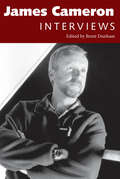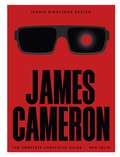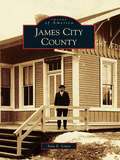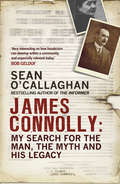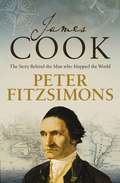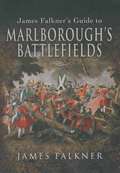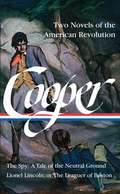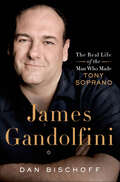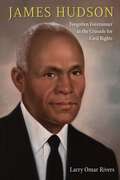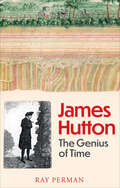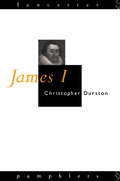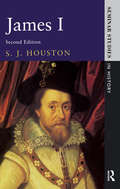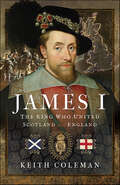- Table View
- List View
James Cameron: Interviews (Conversations with Filmmakers Series)
by Brent DunhamJames Cameron (b. 1954) is lauded as one of the most successful and innovative filmmakers of the last thirty years. His films often break records, both in their massive budgets and in their box-office earnings. They include such hits as The Terminator, Aliens, The Abyss, Titanic, and Avatar. Part scientist, part dramatist, Cameron combines these two qualities into inventive and captivating films that often push the boundaries of special effects to accommodate his imagination. James Cameron: Interviews chronicles the writer-director's rise through the Hollywood system, highlighted by his “can-do” attitude and his insatiable drive to make the best film possible. As a young boy growing up in Canada, Cameron imagined himself an astronaut, a deep-sea explorer, a science fiction writer, or a filmmaker. Transplanted to southern California, he would go on to realize many of those boyhood fantasies. This collection of interviews provides glimpses of the filmmaker as he advances from Roger Corman's underling to “king of the world.” The interviews are drawn from a number of sources including TV appearances and conversations on blogs, which have never been published in print. Spanning more than twenty years, this collection constructs a concise and thorough examination of Cameron, a filmmaker who has almost single-handedly ushered Hollywood into the twenty-first century.
James Cameron: The Complete Unofficial Guide (Iconic Directors)
by Dan JolinGround breaker. Game changer. The King of the World. Director James Cameron went from cult sci-fi rising star to box-office dominator at faster than light speed.As much a technical innovator as he is a visionary artist, Cameron has proven himself the master of his own cinematic destiny. His methods have often been controversial, but the results are undeniably impactful.Taking in his scrappy early days, his impressive breakthrough with The Terminator, his colossal triumph with Titanic, his real-life adventures in planet Earth's most extreme environment, and his astonishing world-building success with Avatar, this is a truly essential guide to Cameron's stellar filmography.
James City County (Images of America)
by Sara E. LewisBeyond museum restorations at Jamestown and neighboring Williamsburg, the history of America's first county is largely unknown to many who visit or live nearby. However, they see and read a multitude of street, neighborhood, and business names that bear silent witness to the county's history. Founded in 1634 atop ancient Algonquin Indian territory, the locality was first made up of plantations and small farms occupied by Europeans and Africans. As they spread out from "James Citie," immigrants sited themselves near rivers and creeks. Waterways provided the earliest transportation network, but interior road maintenance was key to further development of commerce and community. After the Civil War, James City County's population was concentrated along the Toano-Norge-Lightfoot corridor. Communities blossomed along an ancient footpath that followed the Virginia Peninsula's spine. In the 1880s, the railroad paralleled a portion of it, and motorcars followed, making Richmond Road the county's primary thoroughfare. Other community centers included Diascund, Croaker, Chickahominy, Centerville, and Grove.
James Connolly: My Search for the Man, the Myth and his Legacy
by Sean O'CallaghanFROM THE FORMER IRA MEMBER AND AUTHOR OF THE INFORMER, SEAN O'CALLAGHAN'Very interesting on how fanaticism can develop within a community, and especially relevant today.' Bob GeldofThe story of revolutionary James Connolly, his role in the 1916 Easter Rising, and his subsequent influence both on O'Callaghan himself, and on 20th century Irish politics.Easter Monday, 24th April, 1916: James Connolly, a 48-year-old Edinburgh-born Marxist and former British soldier, stands at the top of the steps of Liberty Hall, Dublin. 'We are going out to be slaughtered,' Connolly told his comrades, and with this he set in train the Easter Rising of 1916.Two weeks later, in a scene that has haunted Nationalist Ireland ever since, he was carried to his place of execution having been badly wounded. Placed on a chair, he was shot dead by soldiers of the army he had once served in.This is not a traditional biography; it is a book about Sean O'Callaghan's relationship with a man who was to deeply influence his formative years; it is about the politics of violent extremism that O'Callaghan subsequently became caught up in; and it's about the kind of individuals who are willing to sacrifice everything, including their lives, for a holy cause.Never has a book been more timely.
James Cook: The story behind the man who mapped the world
by Peter FitzSimonsThe name Captain James Cook is one of the most recognisable in Australian history - an almost mythic figure who is often discussed, celebrated, reviled and debated. But who was the real James Cook?This Yorkshire farm boy would go on to become the foremost mariner, scientist, navigator and cartographer of his era, and to personally map a third of the globe. His great voyages of discovery were incredible feats of seamanship and navigation. Leading a crew of men into uncharted territories, Cook would face the best and worst of humanity as he took himself and his crew to the edge of the known world - and beyond.With his masterful storytelling talent, Peter FitzSimons brings the real James Cook to life. Focusing on his most iconic expedition, the voyage of the Endeavour, where Cook first set foot on Australian and New Zealand soil, FitzSimons contrasts Cook against another figure who looms large in Australasian history: Joseph Banks, the aristocratic botanist. As they left England, Banks, a rich, famous playboy, was everything that Cook was not. The voyage tested Cook's character and would help define his legacy.Now, 240 years after James Cook's death, FitzSimons reveals what kind of man James was at heart. His strengths, his weaknesses, his passions and pursuits, failures and successes.James Cook reveals the man behind the myth.
James Cook: The story of the man who mapped the world
by Peter FitzSimonsCaptain James Cook is one of the most recognisable in Australian history - an almost mythic figure who is often discussed, celebrated, reviled and debated. But who was the real James Cook?The name Captain James Cook is one of the most recognisable in Australian history - an almost mythic figure who is often discussed, celebrated, reviled and debated.But who was the real James Cook?This Yorkshire farm boy would go on to become the foremost mariner, navigator and cartographer of his era, and to personally map a third of the globe. His great voyages of discovery were incredible feats of seamanship and navigation. Leading a crew of men into uncharted territories, Cook would face the best and worst of humanity as he took himself and his crew to the edge of the known world - and beyond.With his masterful storytelling talent, Peter FitzSimons brings James Cook to life. Focusing on his most iconic expedition, the voyage of the Endeavour, where Cook first set foot on Australian and New Zealand soil, FitzSimons contrasts Cook against another figure who looms large in Australasian history: Joseph Banks, the aristocratic botanist. As they left England, Banks, a rich, famous playboy, was everything that Cook was not. The voyage tested Cook's character and would help define his legacy.Now, 240 years after James Cook's death, FitzSimons reveals what kind of man James was at heart. His strengths, his weaknesses, his passions and pursuits, failures and successes.JAMES COOK reveals the man behind the myth.
James Cowles Prichard of the Red Lodge: A Life of Science during the Age of Improvement (Critical Studies in the History of Anthropology)
by Margaret M. CrumpMargaret M. Crump offers the first thorough biography of British scientist and physician James Cowles Prichard (1786–1848), an intellectual giant in the developing human sciences, a pioneering psychiatric theorist, and Europe&’s leading anthropologist during the first half of the nineteenth century.
James DeWolf and the Rhode Island Slave Trade (American Heritage)
by Cynthia Mestad JohnsonOver thirty thousand slaves were brought to the shores of colonial America on ships owned and captained by James DeWolf. When the United States took action to abolish slavery, this Bristol native manipulated the legal system and became actively involved in Rhode Island politics in order to pursue his trading ventures. He served as a member of the House of Representatives in the state of Rhode Island and as a United States senator, all while continuing the slave trade years after passage of the Federal Slave Trade Act of 1808. DeWolf's political power and central role in sustaining the state's economy allowed him to evade prosecution from local and federal authorities--even on counts of murder. Through archival records, author Cynthia Mestad Johnson uncovers the secrets of James DeWolf and tells an unsettling story of corruption and exploitation in the Ocean State from slave ships to politics.
James Dean: A Biography
by David DaltonThis is the book that restarted the James Dean cult by celebrating him as the cool, defiant visionary of pop culture who made adolescence seem heroic instead of awkward and who defined the style of rock 'n' roll's politics of delinquency. The only book to fully show how deliberately and carefully Dean crafted his own image and performances, and the product of still unequalled research, vivid writing, intimate photographs, and profound meditation, James Dean: The Mutant King has become almost as legendary as its subject.
James Douglas: Father of British Columbia
by Julie H. FergusonJames Douglas’s story is one of high adventure in pre-Confederation Canada. It weaves through the heart of Canadian and Pacific Northwest history when British Columbia was a wild land, Vancouver didn’t exist, and Victoria was a muddy village. Part black and illegitimate, Douglas was born in British Guiana (now Guyana) in 1803 to a Scottish plantation owner and a mixed-race woman. After schooling in Scotland, the fifteen-year-old Douglas sailed to Canada in 1819 to join the fur trade. With roads non-existent, he travelled thousands of miles each year, using the rivers and lakes as his highways. He paddled canoes, drove dogsleds, and snowshoed to his destinations. Douglas became a hard-nosed fur trader, married a part-Cree wife, and nearly provoked a war between Britain and the United States over the San Juan Islands on the West Coast. When he was in his prime, he established Victoria and secrured the western region of British North America from the Russian Empire and the expansionist Americans. Eventually, Douglas became the controversial governor of the Colonies of Vancouver Island and British Columbia and oversaw the frenzied Fraser and Cariboo gold rushes.
James Durand, An Able Seaman Of 1812: His Adventures On Old Ironsides And As An Impressed Sailor In The British Navy
by James DurandStep aboard the legendary warships of the early 19th century with James Durand, an able seaman whose riveting memoirs offer a vivid glimpse into life at sea during a tumultuous era. In "James Durand, An Able Seaman of 1812," Durand recounts his harrowing experiences on the USS Constitution, famously known as "Old Ironsides," and the British Navy, where he was forcibly impressed into service.Durand’s narrative takes readers on a journey through the heart of the War of 1812, a pivotal conflict between the young United States and Great Britain. With the eloquence of a seasoned storyteller, Durand describes the daily grind of naval life, the brutal realities of battle, and the camaraderie and conflicts among the crew. His tales of courage and resilience highlight the indomitable spirit of sailors who faced not only the dangers of the sea but also the uncertainties of war.From his initial enlistment and the thrill of serving on Old Ironsides to the despair of being captured and impressed into the British Navy, Durand’s memoirs provide a rare and authentic account of maritime history. His firsthand observations offer a unique perspective on the naval strategies and shipboard life of the early 1800s, making this book an invaluable resource for historians and naval enthusiasts alike."James Durand, An Able Seaman of 1812" is more than just a memoir; it is a testament to the enduring human spirit and a poignant reminder of the sacrifices made by those who served at sea. Through Durand’s eyes, readers will experience the relentless pursuit of freedom and the unyielding determination that defined an era. This compelling narrative, rich with historical detail and personal insight, will transport you back in time to witness the adventures and adversities of a seaman caught between two nations.
James Falkner's Guide to Marlborough's Battlefields
by James FalknerThree hundred years ago Queen Anne's Captain-General, John Churchill 1st Duke of Marlborough, led the Allied armies in an epic struggle against the powerful French forces of Louis XIV, in campaigns that stretched across wide areas of the Low Countries, France and Germany. Marlborough's victories at the Schellenberg, Blenheim, Ramillies, Oudenarde and Malplaquet are among the most remarkable feats in all of British military history. Marlborough broke France's military power for a hundred years. As James Falkner demonstrates in this, the first full-scale guide to the subject, the story of these famous campaigns makes compelling and exciting reading, and the sites associated with them are evocative places that can easily be visited today. His battlefield guide is essential reading for anyone who is keen to understand the military history of the era, and it is an invaluable companion for visitors to the many battlefields associated with Marlborough's triumphs.
James Fenimore Cooper: A Life
by Nick LourasJames Fenimore Cooper (1789-1851) was America&’s first novelist, celebrated for his masterpiece, The Last of the Mohicans. Over a prolific career he created a national mythology that endures to this day. According to Daniel Webster, &“We may read the nation&’s history in his life.&” Yet Cooper was also a provocative figure, ultimately disillusioned with American democracy. He spent his boyhood in the wilds of the frontier, served as a merchant sailor and naval officer, traveled the courts of Europe in an age of upheaval and returned home to scandal and controversy. He conquered the literary world only to fall victim to his own fame. In the first popular biography of Cooper in a generation, historian Nick Louras brings the man and his age vividly to life.
James Fenimore Cooper: The Later Years
by Wayne FranklinA definitive new biography of James Fenimore Cooper, early nineteenth century master of American popular fiction American author James Fenimore Cooper (1789–1851) has been credited with inventing and popularizing a wide variety of genre fiction, including the Western, the spy novel, the high seas adventure tale, and the Revolutionary War romance. America’s first crusading novelist, Cooper reminds us that literature is not a cloistered art; rather, it ought to be intimately engaged with the world. In this second volume of his definitive biography, Wayne Franklin concentrates on the latter half of Cooper’s life, detailing a period of personal and political controversy, far-ranging international travel, and prolific literary creation. We hear of Cooper’s progressive views on race and slavery, his doubts about American expansionism, and his concern about the future prospects of the American Republic, while observing how his groundbreaking career management paved the way for later novelists to make a living through their writing. Franklin offers readers the most comprehensive portrait to date of this underappreciated American literary icon.
James Fenimore Cooper: The Spy: A Tale of the Neutral Ground / Lionel Lincoln; or, The Leaguer of Boston (Library of America James Fenimore Cooper Edition #4)
by James Fenimore Cooper Alan TaylorThe American Revolution comes to vivid life in two dramatic tales of espionage, intrigue, and romance from the author of The Last of Mohicans.With his second novel, The Spy:A Tale of the Neutral Ground, in 1821, James Cooper (the Fenimore would come later) found his true voice and what became his most enduring subject matter: the history of his young nation, born of the clash between Old World and New. Set largely in Westchester County--site of the real-life intrigues of Benedict Arnold and Major John Andre--The Spy traces the conflicting allegiances of rebels and loyalists, with the supposed loyalist spy Harvey Birch (actually in the service of George Washington) finding himself caught up in conflicts between friendship and duty as he moves between the two sides. Washington himself makes an incognito appearance as the mysterious "Mr. Harper." Cooper continued in the same vein with Lionel Lincoln; Or, The Leaguer of Boston (1825), a carefully researched panorama of the coming of the Revolution, complete with detailed depictions of the battles of Lexington and Concord and Bunker Hill. With the hero a native-born American serving in the British Army, issues of loyalty are again complex, and some American reviewers, not for the last time, found Cooper's politics a bit too ambiguous for comfort.LIBRARY OF AMERICA is an independent nonprofit cultural organization founded in 1979 to preserve our nation’s literary heritage by publishing, and keeping permanently in print, America’s best and most significant writing. The Library of America series includes more than 300 volumes to date, authoritative editions that average 1,000 pages in length, feature cloth covers, sewn bindings, and ribbon markers, and are printed on premium acid-free paper that will last for centuries.
James FitzGibbon: Defender of Upper Canada
by Ruth McKenzieJames FitzGibbon, Defender of Upper Canada, is the often poignant story of a poor man’s rise to authority in the Upper Canada of the 1800s. Born the son of a tenant farmer in Ireland, FitzGibbon’s valour as a soldier brought him to the attention of those destined for power in the Canadas. Hero of the Battle of Beaver Dams in 1813, one o the decisive battles in the War of 1812, FitzGibbon’s brilliance as tactician and negotiator was needed time and again — whether to settle Irish unrest on the Cornwall Canal, or to organize Toronto’s defence against William Lyon Mackenzie’s rebel forces in 1837. As a public administrator, FitzGibbon’s rise was slow and disappointing. Despite holding a multitude of offices, he was continually in debt. And despite repeated petitions, FitzGibbon’s tireless military and public services went unrecognized and unrewarded. His final reward as a ceremonial knight in Windsor Castle adds a tragicomic touch to a fascinating tale.
James Fitzjames: The Mystery Man of the Franklin Expedition
by William BattersbyJames Fitzjames was a hero of the early nineteenth-century Royal Navy. A charismatic man with a wicked sense of humour, he pursued his naval career with wily determination. When he joined the Franklin Expedition at the age of 32 he thought he would make his name. But instead the expedition completely disappeared and he never returned. Its fate is one of history’s last great unsolved mysteries, as were the origins and background of James Fitzjames – until now. Fitzjames packed a great deal into his thirty-two years. He had sailed an iron paddle steamer down the River Euphrates and fought with spectacular bravery in wars in Syria and China. But Fitzjames was not what he seemed. He concealed several secrets, including the scandal of his birth, the source of his influence and his plans for after the Franklin Expedition. In this first complete biography of the captain of the HMS Erebus, William Battersby draws extensively on Fitzjames’ personal letters and journals – most never published before – as well as official naval records, to strip away 200 years of misinformation and half-truths and enables us to understand for the first time this intriguing man and his significance for the Franklin Expedition.
James Gandolfini: The Real Life of the Man Who Made Tony Soprano
by Dan BischoffJames Gandolfini: The Real Life of the Man Who Made Tony Soprano is the first biography of the actor who died, in June 2013 at age 51, widely recognized as one of the best—and most defining—actors of his generation. The book is informed by fresh interviews with Sopranos actors, the star's acting teachers and coaches, his childhood friends, buddies from his days as a nightclub bouncer, and Hollywood figures including the directors of his posthumously released films. Bischoff decodes Gandolfini's portrayal of mobsters and bad guys from his breakout role in True Romance with Patricia Arquette to the television series role that made his career, and his portrayals of real people like Leon Panetta in Zero Dark Thirty. Gandolfini's personal life--from his marriages and family interactions to his deep friendships with his fellow cast members—enriches and enlivens this book, and deepens our understanding of the star.James Gandolfini: The Real Life of the Man Who Made Tony Soprano is a fascinating look at Gandolfini's complicated relationship to his roots, to the role that made him wealthy beyond his imagination, and to American notions of masculinity, power and fame. Even as he scaled the heights of his profession, creating a TV character as vivid as Carroll O'Connor's Archie Bunker and as volcanic as Marlon Brando's Stanley Kowalski, Gandolfini remained a reluctant celebrity dedicated more to his craft than to his career. James Gandolfini: The Real Life of the Man Who Made Tony Soprano delivers a textured, multilayered portrait of the on- and off-screen life of a complex, talented man who rose from an Italian immigrant family in northern New Jersey to join the ranks of America's most iconic actors.
James Garfield & the Civil War: For Ohio and the Union
by Daniel J VermilyaThis biography of America&’s twentieth president sheds light on his Civil War years, when he served as a major general for the Union Army. While his presidency was tragically cut short by his assassination, James Abraham Garfield's eventful life covered some of the most consequential years of American history. When the United States was divided by war, Garfield was one of many who stepped forward to defend the Union. In this biography, historian Daniel J. Vermilya reveals the little-known story of Garfield's role in the Civil War. From humble beginnings in Ohio, Garfield rose to become a major general in the Union army. His military career took him to the backwoods of Kentucky, the fields of Shiloh and Chickamauga, and ultimately to the halls of Congress. His service during the war established Garfield as a courageous leader who would one day lead the country as president.
James Henry Hammond and the Old South: A Design for Mastery (Southern Biography Series)
by Drew Gilpin FaustFrom his birth in 1807 to his death in 1864 as Sherman's troops marched in triumph toward South Carolina, James Henry Hammond witnessed the rise and fall of the cotton kingdom of the Old South. Planter, politician, and partisan of slavery, Hammond built a career for himself that in its breadth and ambition provides a composite portrait of the civilization in which he flourished.A long-awaited biography, Drew Gilpin Faust's James Henry Hammond and the Old South reveals the South Carolina planter who was at once characteristic of his age and unique among men of his time. Of humble origins, Hammond set out to conquer his society, to make himself a leader and a spokesman for the Old South. Through marriage he acquired a large plantation and many slaves, and then through shrewd management and progressive farming techniques he soon became one of the wealthiest men in South Carolina. He was elected to the United States House of Representatives and served as governor of his state. A scandal over his personal life forced him to retreat for many years to his plantation, but eventually he returned to public view, winning a seat in the United States Senate that he resigned when South Carolina seceded from the Union.James Henry Hammond's ambition was unquenchable. It consumed his life, directed almost his every move, and ultimately, in its titanic calculation and rigidity, destroyed the man confined within it. Like Faulkner's Thomas Sutpen, Faust suggests, Hammond had a "design," a compulsion to direct every moment of his life toward self-aggrandizement and legitimation. Hammond envisioned himself as the benevolent, paternal, but absolute master of his family and his slaves. But in reality, neither his family, his slaves, nor even his own behavior was completely under his command. Hammond ardently wished to perfect and preserve the southern way of life. But these goals were also beyond his control. At the time of his death it had become clear to him that his world, the world of the Old South, had ended.
James Hudson: Forgotten Forerunner in the Crusade for Civil Rights
by Larry Omar RiversThis book tells the story of James Hudson, a Black philosopher, Florida A&M University professor, activist, and religious leader whose philosophical contributions laid a key piece of the groundwork for the emergence of the civil rights movement.
James Hutton: The Genius of Time
by Ray PermanDiscover one of the Scottish Enlightenment's brightest stars. Among the giants of the Scottish Enlightenment, the name of James Hutton is overlooked. Yet his Theory of the Earth revolutionised the way we think about how our planet was formed and laid the foundation for the science of geology. He was in his time a doctor, a farmer, a businessman, a chemist yet he described himself as a philosopher – a seeker after truth. A friend of James Watt and of Adam Smith, he was a polymath, publishing papers on subjects as diverse as why it rains and a theory of language. He shunned status and official position, refused to give up his strong Scots accent and vulgar speech, loved jokes and could start a party in an empty room. Yet much of his story remains a mystery. His papers, library and mineral collection all vanished after his death and only a handful of letters survive. He seemed to be a lifelong bachelor, yet had a secret son whom he supported throughout his life. This book uses new sources and original documents to bring Hutton the man to life and places him firmly among the geniuses of his time.
James I (Lancaster Pamphlets)
by Christopher DurstonJames I has traditionally been portrayed as a foolish and unpleasant man. However, the last two decades have seen a rehabilitation of James I by historians, who have begun to appreciate that in some areas, in particular foreign policy and religion, he pursued sensible policies and achieved a considerable degree of success. Christopher Durston deals with the personality and political ability of the monarch, the court, finance, parliament, foreign policy and religion, including his record in Scotland and the legacies of Elizabeth I. The arguments of the revisionist historians concerning James's relations with his parliaments are examined in detail, as well as the recent `postrevisionist' backlash.
James I (Seminar Studies)
by S. J. HoustonSince publication in 1973 James I has established itself as one of the most popular short accounts of James I's reign. The First Edition was described by John Morrill as `a far better, shrewder, more incisive account of the reign' than the available competition Seventeenth-Century Britain, 1980. The text has now been entirely rewritten to take account of the latest historiography and students will continue to welcome this accessible analysis of the problems, weaknesses and achievements of James I as it enables them to participate in the revisionist arguments that make the study of this period so stimulating.
James I, The King Who United Scotland and England
by Keith ColemanThe life of King James VI who united England and Scotland under one crown and became James I in 1603 is marked by contradictions. Generally praised as a good king of Scotland and a poor English one, James was a deep theological thinker, but he also inspired a superstitious frenzy which resulted in the North Berwick witch hunt and trials in the 1590s. Scholar and pedant, he was in his own view God’s appointed ruler, yet also a foul mouthed sloven and forever tarnished with the title of the Wisest Fool in Christendom. The most glaring contrast in his personal life was between his image as a married family man and as a ruler who lavished indiscreet affection on a series of men whom he invested with considerable power. This book approaches James through the lens of his relationships with his major favorites. First was Anglo-French lord Esme D’Aubigny, then Scottish squire Robert Carr (later Earl of Somerset), and finally the consummate nobleman George Villiers, Duke of Buckingham. ‘A king will have need to use secrecy in many things,’ the king wrote in one of his books. Although his private life was sometimes astonishingly visible, there are still many mysteries about James I as a man rather than a ruler. This work tracks the king’s life from a barren childhood through a succession of plots, intrigues and conspiracies in Scotland which largely forged, or deformed, his character. Beyond his complex and disputed connection with these men the book looks at his relationship with his wife, sponsorship of the arts, and contains a reappraisal of the first and most neglected historical mystery of his first reign, the Gowrie Conspiracy.
